The Artistry Behind Custom Made Pendants
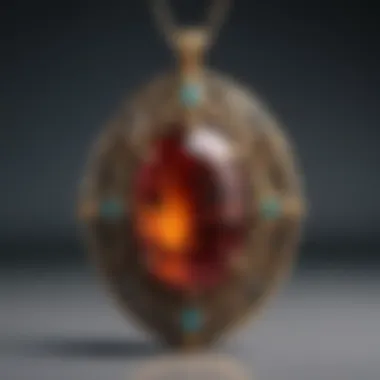
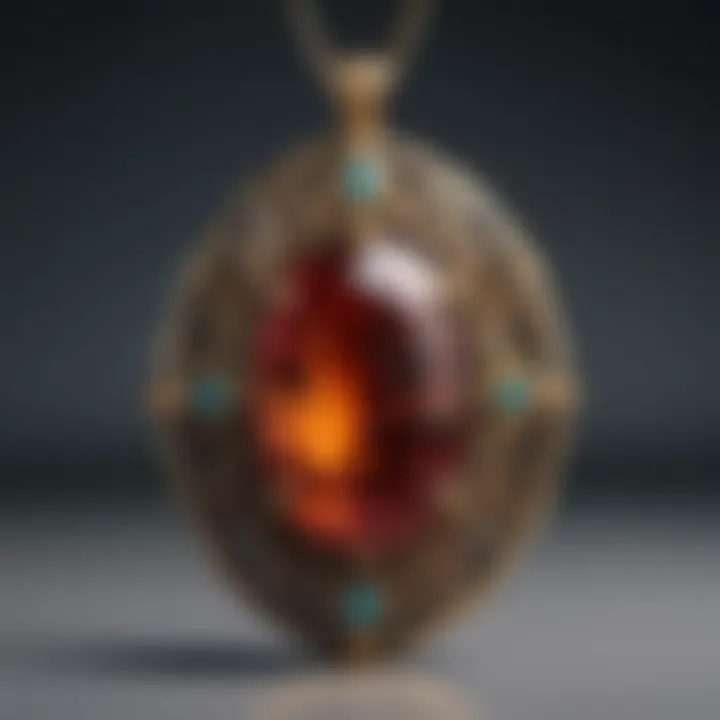
Intro
Custom made pendants resonate deeply with personal stories, emotions, and a sense of individuality. They serve as more than just decorative items; each piece can encapsulate a memory, a milestone, or a cherished relationship. Whether it’s a pendant shaped like a favorite animal, engraved with initials, or filled with meaningful gemstones, these creations reflect the tastes and sentiments of the wearer.
Designing a custom pendant involves blending artistic vision with practical skills. Artists and jewelers work hand-in-hand with clients, transforming abstract ideas into tangible treasures. This process begins with understanding the desired themes, materials, and styles. It culminates in a one-of-a-kind piece of jewelry that has oftentimes more significance than mass-produced alternative.
In this exploration, we will unfold the multifaceted world of custom made pendants. We will examine the jewelry making journey—from the selection of gemstones to the various cultural significances attached to these adornments. By diving into the artistry and techniques involved, readers can appreciate why personalized jewelry has a timeless appeal that resonates in today’s market.
Prologue to Custom Made Pendants
Custom made pendants represent a unique intersection of artistry and personal expression in the world of jewelry design. They offer an opportunity for individuals to own a piece that not only complements their style but also imbues their personality. As the demand for individualized adornments grows, understanding the significance, history, and aesthetic versatility of these custom pieces gains importance.
Through this exploration, we will uncover not just the craft but also the emotional narratives that these pendants convey. From symbols of love to tokens of memory, custom pendants hold immeasurable value in a world that often prioritizes mass-produced ornaments.
Concept and Purpose
At its core, the concept of custom made pendants hinges on personalization. Unlike standard jewelry, a custom pendant is crafted according to one’s specific desires, making it a reflection of the wearer’s identity. It can be designed to celebrate milestones, evoke memories, or simply express one's artistic inclinations. The purpose transcends mere decoration; it becomes a medium through which stories are told and sentiments are conveyed.
For enthusiasts and collectors, these pendants fulfill a deeper purpose. They serve as conversation starters, potential heirlooms, and representations of one’s journey through life.
Historical Context
The history of pendants stretches back to ancient civilizations, with their origins rooted in practicality and spirituality. From the ancient Egyptians who adorned their necks with intricate amulets believed to offer protection, to indigenous cultures using natural materials to convey spiritual beliefs, pendants have always had a purpose that melds art with meaning.
As societies evolved, so too did the aesthetics and materials employed in pendant making. The Middle Ages, for instance, saw the rise of gemstones, which were not just decorative, but carried astrological significance or were believed to possess healing properties.
By the time we reached the Renaissance, artisans began to push boundaries, introducing enameling and new techniques that added colors and complexity, making each piece a canvas of artistic expression. Today, the adaptability of modern tools and techniques redefines the lens through which we view custom pendants, merging age-old concepts with contemporary aesthetics.
"The beauty of a custom pendant lies not just in what it looks like, but in the stories it carries and the connections it nurtures through time."
In understanding the concept and historical significance of custom pendants, we can better appreciate the value they hold in today’s jewelry landscape.
Materials Used in Custom Pendants
The choice of materials in crafting custom made pendants plays a vital role in defining their overall aesthetic and durability. Each material brings its unique essence, influencing the pendant's weight, texture, and visual appeal. Understanding these materials not only helps artisans craft exquisite pieces but also empowers consumers to make informed choices that reflect their personal styles and values.
Precious Metals
Gold
Gold has long been a staple in jewelry design, and for good reason. Its natural luster and resistance to tarnish make it an ideal choice for pendants that are both beautiful and enduring. One of gold's most captivating traits is its malleability; it can be shaped into intricate designs without losing its integrity. This flexibility allows artisans to create unique, personalized pieces tailored to individual preferences.
However, gold can be a double-edged sword. While its beauty is undeniable, its cost can be quite steep, particularly in its purest form. Moreover, not everyone is aware that gold jewelry can contain alloy metals, which can affect its color, durability, and hypoallergenic properties. This is a crucial consideration for individuals with sensitive skin.
Silver
Silver is another popular choice for custom pendants, characterized by its bright sheen and affordability compared to gold. Its lower price point makes it accessible to a wider audience, enabling more people to enjoy custom jewelry without breaking the bank. Moreover, silver can be polished to a dazzling shine, highlighting the intricate details crafted by artisans.
On the downside, silver is more prone to tarnishing, requiring regular maintenance to keep it looking its best. This can be a drawback for those who prefer low-maintenance accessories. Nevertheless, its versatility in design and affordability, as well as its antibacterial properties, make silver a timeless and practical choice for many.
Platinum
Platinum stands out as a premium choice for custom pendants, often heralded for its density and rarity. Unlike gold and silver, platinum’s durability ensures that it withstands the test of time, making it a fitting option for heirloom pieces. Its natural white sheen does not fade or tarnish, allowing it to maintain its beauty with minimal upkeep.
Despite its high-quality features, the price of platinum can be daunting, often exceeding the costs of gold. This price tag makes it less accessible for casual buyers. Despite this, individuals seeking extraordinary quality and craftsmanship often find platinum to be the pinnacle of luxurious materials.
Gemstones and Crystals
Types of Gemstones
The use of gemstones in custom pendants can breathe life and character into any piece. With varieties ranging from diamonds to sapphires to more exotic choices like opals or labradorite, wearers can express their unique tastes. Gemstones are not just visually appealing; they also carry meanings and associations, making them a powerful addition to personalized jewelry.
Each type of gemstone comes with its benefits and drawbacks. For instance, while diamonds may symbolize strength and resilience, they come with a hefty price tag. On the other hand, more accessible stones like amethyst or citrine can offer similar beauty and significance without a financial burden, making them an excellent choice for those on a budget.
Sourcing Gemstones
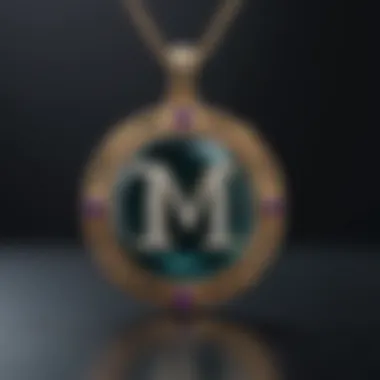
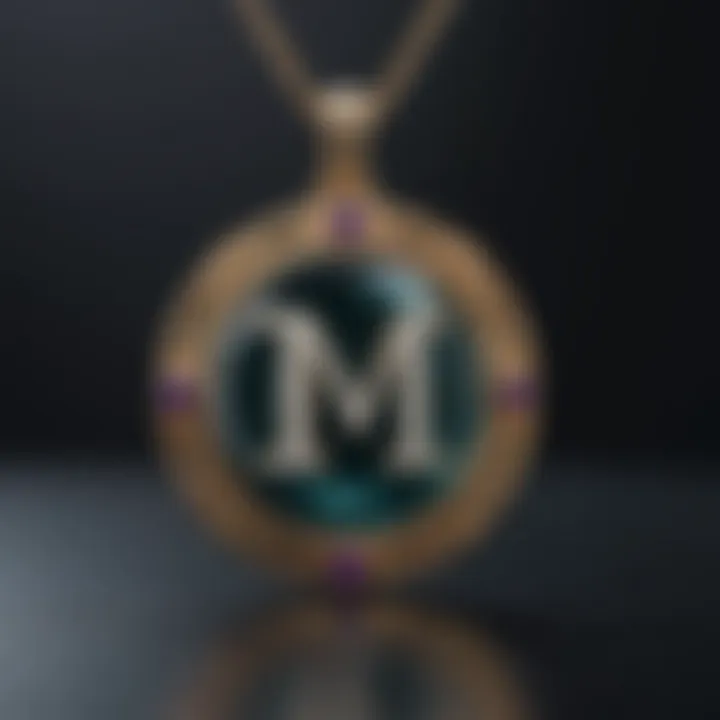
Knowing where and how gemstones are sourced is paramount in the world of custom pendants. Ethical sourcing ensures that materials are acquired in a way that respects human rights and the environment. Many consumers are increasingly interested in the journey of their gemstones, often opting for conflict-free stones or those sourced from sustainable mines.
While ethically sourced gemstones can often command a higher price, they offer peace of mind to consumers who want their purchases to reflect their values. However, the challenge often lies in finding reliable suppliers who can provide authentic and ethically sourced materials, thus making research and careful consideration a priorities when embarking on a custom jewelry journey.
Alternative Materials
Wood
Wood offers a refreshing and organic aesthetic, unrivaled by traditional metals and stones. It can be crafted into unique shapes and designs, bringing warmth to the jewelry. This material can be an excellent choice for eco-conscious consumers, as it is sustainably sourced and biodegradable, often giving a distinctive character to each pendant.
Nevertheless, wood does have its shortcomings. It can be more susceptible to moisture damage and wear over time compared to metals or stones. Care must be taken to ensure longevity, and protective coatings may be required to maintain its appearance.
Resin
Resin is a modern marvel in custom jewelry, allowing artisans to encase objects, including flowers or pigments, creating one-of-a-kind pieces rich in color and depth. The beauty of resin is in its versatility; it can mimic other materials while allowing for extraordinary creativity in design.
However, low-quality resin can yellow over time, and it may not withstand high heat or extreme conditions. Thus, when choosing resin for pendant designs, quality and craftsmanship become paramount to ensure durability and appeal.
Ceramics
Ceramic materials bring a unique texture and style, often showcasing brilliant colors and patterns. Ceramics can be molded and glazed in almost limitless ways, allowing personalization to reach extraordinary heights. Their lightweight nature makes them comfortable to wear, presenting a distinctive alternative to heavier metals and stones.
As with wood, ceramics can be fragile and may chip or crack if not handled with care. This makes them a less practical choice for everyday wear, and they are generally better suited for special occasions or as decorative items.
In summary, the materials used in custom pendants play a critical role in both aesthetics and functionality. From traditional precious metals to organic options like wood and contemporary choices such as resin, each element provides unique qualities that can cater to varied tastes and preferences. The key is for consumers to weigh their options carefully, considering not only beauty but also practicality and ethical implications that come with each material choice.
Design Inspirations for Custom Pendants
When it comes to custom pendants, inspiration can spring from virtually anywhere. The beauty of personalized jewelry lies in the variety of designs that can resonate with individual tastes and memories. Diving into design inspirations not only enhances the aesthetic appeal of pendants but also imbues them with rich layers of meaning. By focusing on how different elements can inspire unique creations, we can see the ways they cater to diverse preferences and tell stories that are deeply personal.
Nature-Inspired Designs
Nature has always been a pivotal source of inspiration in art, and jewelry design is no exception. From the delicate contour of leaves to the majestic forms of animals, nature-inspired designs capture the essence of the world around us.
An artisan might replicate the texture of tree bark, giving a pendant an organic feel while connecting the wearer to the great outdoors. Similarly, incorporating elements like flowers or waves can evoke feelings of serenity and reverence for nature's beauty.
- Personal Connection: For many, wearing a nature-inspired pendant can be a reminder of cherished moments spent outdoors. This connection adds a sentimental layer, allowing one's personality to shine through the jewelry.
- Material Choices: Designs may also incorporate natural materials such as wood or stones, which can enhance the visual experience of the piece. These materials resonate with an earthy aesthetic and often carry a story of their own, related to their origin.
“In every work of art, nature sings through the lines and curves, echoing stories of life that transforms into a wearable memory.”
Geometric Shapes
The world of geometry opens a fascinating realm for custom pendant design. Shapes like triangles, circles, or polygons can result in striking pieces that stand out for their simplicity and elegance.
Geometric patterns offer both modernity and a touch of classicism, standing the test of time through various design trends. Whether it's a simple triangular pendant or a complex interwoven pattern, these forms convey a sense of balance and harmony.
- Versatility: Geometric shapes are incredibly versatile, suitable for both casual wear and formal occasions. They can be made from a variety of materials ranging from shiny metals to matte finishes.
- Symbolism: Shapes often bear particular meanings. For instance, triangles can represent strength or change, while circles convey notions of continuity and wholeness. This allows the designs to reflect personal values and aspirations.
Cultural Symbols and Motifs
Custom pendants can also reflect cultural heritage through carefully chosen symbols and motifs. These designs celebrate a rich palette of traditions, often paying homage to various cultures' arts and beliefs.
An example might include Celtic knots, which symbolize interconnection, or Native American designs that honor spirituality and nature. Each of these motifs carries a wealth of history and meaning, often linked to identity or cultural pride.
- Preserving Heritage: Incorporating cultural symbols allows people to express their identity and maintain a connection to their roots. This is particularly significant for those who want their jewelry to reflect who they are and where they come from.
- Stories and Legends: Many symbols have stories or legends attached to them, adding depth to the pendants. Choosing these designs can be a conversation starter, inviting others to appreciate and understand their personal significance.
Personalization Options in Custom Jewelry
Personalization is at the very heart of custom made pendants. It breathes life into the pieces, transforming them from mere accessories into remarkable reflections of the wearer's identity and values. This aspect of jewelry creation prompts a deeper connection between the object and the individual, forging memories and sentiments that are intertwined with the craftsmanship. The beauty of custom jewelry lies in its ability to communicate personal stories, celebrate milestones, or simply express one's unique style.
When considering personalization options, there are various elements that stand out, including engraving techniques and the myriad of colors and finishes available. Engraving, for instance, allows for a personal touch that can carry deep emotional significance, whether it's a name, date, or a phrase that resonates with the wearer. On the other hand, the choice of colors and finishes can bring the design to life, making it even more distinctive. Together, these options create a canvas for self-expression, ensuring that each pendant tells its own tale.
Engraving Techniques
Engraving techniques can vary widely, each offering a different aesthetic and touch. Popular methods include:
- Laser Engraving: This modern technique uses high-precision lasers to carve intricate designs and text onto the surface of metals and gemstones. The advantage of laser engraving is its ability to achieve detailed results without compromising the integrity of the material.
- Hand Engraving: As the name implies, this method relies on traditional tools wielded by skilled artisans. Hand engraving allows for a creative freedom that laser techniques may not capture, enabling unique patterns and textures that reflect the artisan's personal style.
- Deep Engraving: This technique involves carving deeper into the material, giving a more pronounced and durable design. It's often used for symbols or lettering that need to withstand wear and tear.

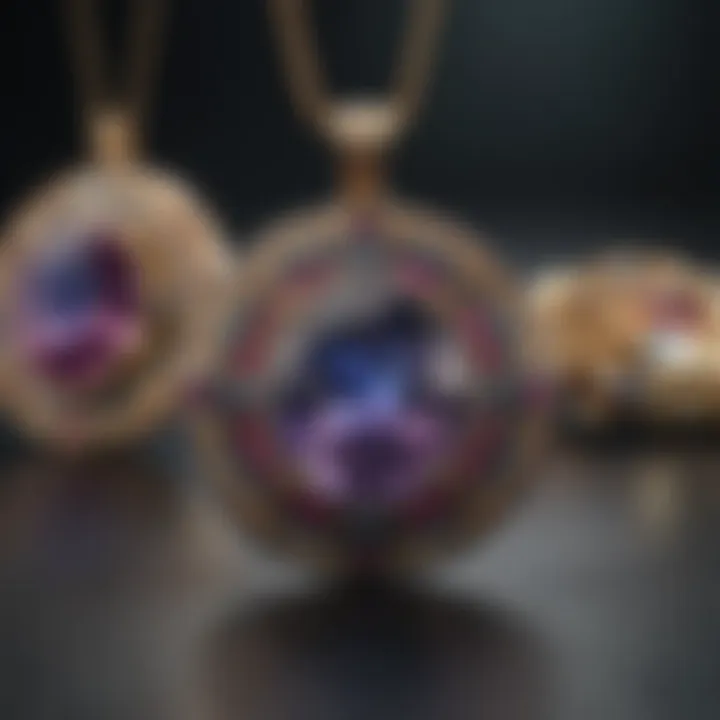
Each of these methods comes with its own set of benefits. While laser engraving offers speed and accuracy, hand engraving imparts a level of individuality to the piece that machine-made items simply can't match.
Choosing Colors and Finishes
Selecting colors and finishes is another crucial aspect of personalization in custom pendants. This choice determines the overall aesthetic and emotional tone of the piece.
- Metal Finishes: Pendants can take on a variety of metal finishes such as polished, matte, or brushed. Each finish alters the way light interacts with the metal, producing different visual effects.
- Gemstone Colors: Colored gemstones can serve as focal points in custom pendants. The choice of hue can symbolize an array of meanings; for example, blue sapphires often embody wisdom, while vibrant greens may suggest renewal.
- Inlays and Accents: Customization can also extend to the addition of inlaid materials such as enamel or contrasting metals, further enhancing the overall design.
"Personalization transforms a pendant from a simple ornament to a tangible narrative, inviting the wearer to celebrate their unique journey."
These personalization elements elevate the artwork of pendant design, compelling artisans to blend craftsmanship with individual expression. The choice seems vast, yet this variety allows each piece to resonate deeply with its wearer, making it a cherished entity crafted uniquely for them.
The Process of Creating Custom Made Pendants
Creating custom made pendants is both an art and a science, involving a meticulous process that transforms imagination into tangible jewelry. Each step in this journey serves a specific purpose that combines the desires of the customer with the skillset of the artisans, ensuring that every piece reflects unique personality and craftsmanship. Understanding the nuances of this process can offer significant insight into the vibrant world of personalized jewelry and how it caters to the tastes and preferences of modern consumers.
Consultation with Artisans
Before any metal is melted or gem is set, a conversation takes place. Consultation with artisans is the bedrock of the custom pendant-making journey. Here, the expectations and ideas of the client meet the expertise of the craftsman. It's a crucial first step because the details discussed during this stage lay the groundwork for the entire project. The artisan’s experience in design, materials, and techniques plays a significant role in shaping the envisioned piece into a reality.
Clients articulate their preferences—whether they want something straightforward or intricately detailed. Artisans often provide guidance on styles, functional aspects, and possible limitations based on materials. This dialogue not only fosters relationships but also helps in refining ideas to ensure the final product is satisfactory and represents the client's vision accurately. A well-executed consultation can yield a treasure that resonates on a personal level.
Sketching and Prototyping
Once the consultation is complete, the next step is sketching and prototyping. Artisans take the ideas gathered and translate them into visual representations. This stage allows for creativity to flow freely, with artisans sketching multiple concepts based on the consultation notes.
Using tools like pencils, erasers, and digital software, they create designs that capture the essence of what the client wants. Prototypes may also be crafted from less expensive materials to evaluate shape and feel before committing to precious metals and gemstones. It's a pivotal moment that ensures the client can visualize the piece before final production begins. Feedback received during this step is invaluable, allowing adjustments to be made swiftly, ensuring the final piece truly embodies the original vision.
Final Production Techniques
The final production techniques are where the magic happens. Each technique utilized is essential in shaping the pendant from a mere idea into a finished jewel.
Casting
One of the most fundamental techniques in pendant creation is casting. This method involves pouring molten metal into a mold to form the desired shape. The primary characteristic of casting is its ability to create detailed designs that can be difficult or nearly impossible to achieve through other techniques. Its popularity stems from its efficiency and precision, allowing artisans to replicate intricate designs consistently while maintaining a high level of craftsmanship.
The unique aspect of casting is that it opens up numerous creative avenues. Artisans can play with texture and detail, often incorporating unique patterns or motifs that reflect the client’s identity. However, it does come with its drawbacks; the cost of professional-grade casting equipment can be a barrier for smaller artisans, and mistakes in the casting process can lead to wasted materials, which also impacts project timelines.
Setting Stones
Setting stones is another vital component in the final production stage. This technique involves securing gemstones into the pendant securely, enhancing its beauty and value. The key characteristic of stone setting is its necessity for precision and delicacy, as a poorly set stone can not only detract visually but could be lost easily.
The process of setting is beneficial in increasing the aesthetic appeal of the pendant, allowing artisans to showcase vibrant gems in various cuts and colors. The capability to set stones can also differentiate a custom piece from mass-produced jewelry, making it distinctive. However, this technique requires skilled hands; not every jeweler can master it, which might limit the options available for clients.
Finishing Touches
Lastly, but by no means least, are the finishing touches. This is the stage when a pendant receives its final polish, texture, or any adjustments to ensure it meets the envisioned look. Whether it's adding a glossy finish or employing more rustic treatment methods, these touches enhance the appeal significantly, allowing the pendant to shine its brightest.
The uniqueness of finishing touches lies in the detail and personal creativity they can convey. Choosing to add a personalized engraving or opting for a specific polish can set the piece apart. While it might seem minor, the impact is substantial. However, hasty finishing can result in scratches or uneven tones, which can spoil what would otherwise be a masterpiece.
Each step in the process of creating custom pendants harmoniously ties together the visions, techniques, and skills of artisans and the desires of clients, making it a rewarding journey in the ever-evolving world of jewelry design.
Market Trends in Custom Pendant Jewelry
The landscape of custom pendant jewelry is as vibrant and diverse as the materials used to create it. Understanding the market trends not only informs consumers about their choices but also provides artisans and designers with valuable insights into what captivates buyers. As we explore growing personalization and the e-commerce boom, we see how these elements are reshaping the way custom pendants are conceived and crafted.
Growing Popularity of Personalized Jewelry
Personalized jewelry has ventured beyond mere trendiness to become a staple in the marketplace. There's an undeniable allure when it comes to wearing something that uniquely represents one’s identity, story, or even relationships. Consequently, consumers are increasingly gravitating towards pieces that resonate with their individual styles and experiences.
- Uniqueness: In a world swamped with mass-produced items, people crave uniqueness. Custom pendants allow individuals to express who they are in a way that standard jewelry simply cannot.
- Sentimental Value: Items that carry a sentimental touch often become cherished heirlooms. Whether it’s an engraved date or a pendant molded from a loved one’s handwriting, these details deepen the emotional link to the jewelry.
- Versatility in Design: Artists are continuously experimenting with designs, making it easy for consumers to tailor their pendants according to personal narratives. From initials to symbolic shapes, the sky is the limit.
The melding of artistry with personal expression not only makes these pieces fashionable but also essential to one's personal collection. As more consumers recognize the intrinsic value of custom jewelry, personalization is expected to continue its upward trajectory, shaping future market offerings.
E-commerce Impact on Custom Jewelry
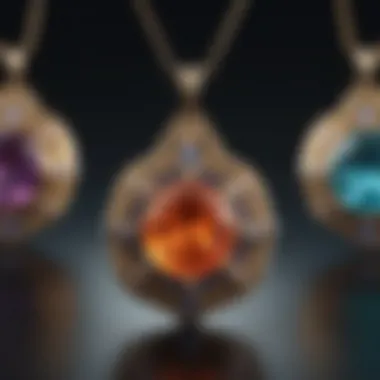
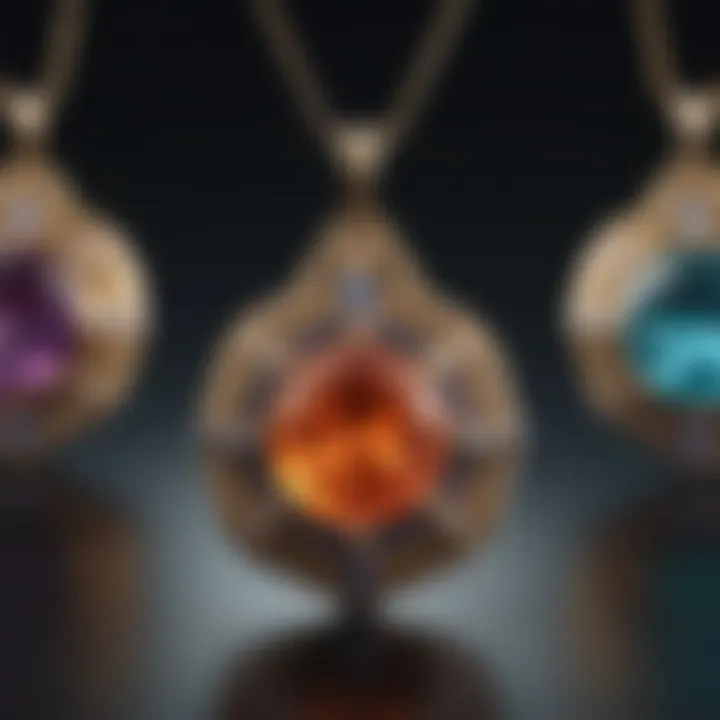
The rise of e-commerce has transformed how people engage with custom jewelry, making it easier and more accessible than ever before. The digital marketplace bridges the gap between consumers and artisans, facilitating a more personal shopping experience, which is crucial in this field. Here’s how:
- Wider Reach: Artisans can showcase their creations to a global audience, allowing niche designs to find homes far from their original studios.
- Convenience: Shoppers appreciate the ability to browse and order custom pieces from the comfort of their own homes. This ease encourages impulse buying and increases the likelihood of purchasing custom items, often with just a few clicks.
- Tailored Experiences: Many online platforms now offer tools that let consumers visualize their custom jewelry. Interactive features where one can design a pendant in real time or select preferences enhance customer engagement and satisfaction.
Indeed, e-commerce has not just expanded the market; it has transformed consumer relationships with artists. The barriers have come down, opening doors to creativity and collaboration. As buying patterns continue to evolve, keeping an eye on these trends will help both consumers and creators navigate the ever-changing terrain of custom pendant jewelry.
"The interplay between emotion and design gives birth to jewelry that holds meaning far beyond its physical form."
In summary, the market trends in custom pendant jewelry reflect a growing desire for personalization accompanied by the convenience of e-commerce. As artisans adapt to these shifts, we can be assured that custom-made pendants will remain a cherished form of expression.
Cultural and Emotional Significance of Pendants
In the world of jewelry, pendants often transcend their mere function as adornment; they embody deep cultural and emotional meanings. These pieces whisper stories of identity, heritage, and personal milestones, adding layers of significance that resonate with both wearers and admirers. From ancient traditions to contemporary practices, the importance of pendants in various cultures cannot be overstated. They serve as a bridge connecting past with present, both reflecting and shaping the wearer's journey.
Pendants as Symbols of Identity
Pendants frequently act as powerful symbols of identity, providing a canvas for expressing individuality, beliefs, and affiliations. They can reflect cultural backgrounds or personal narratives, be it through unique motifs, materials, or stones that hold specific meaning. For example, wearing a pendant shaped like a family crest can not only demonstrate connection to one’s lineage but also remind the wearer of their roots and values.
Additionally, many cultures incorporate specific symbols into their jewelry, which carry teachings and stories. A Native American turquoise pendant might encapsulate spiritual grounding, while a Celtic knot signifies eternal life and interconnectedness. These pieces serve to affirm one's identity in a world often filled with uncertainty.
Moreover, personalization elevates these pendants further. Engraving initials, important dates, or even heartfelt phrases transforms a simple piece of jewelry into a cherished emblem of one's life journey. Whether someone is marking a significant milestone like a graduation or commemorating a lost loved one, choosing a pendant becomes a deeply personal decision, intertwining emotions and identity into a tangible form.
"A pendant is more than just a piece of jewelry; it encapsulates memories, beliefs, and the essence of who we are."
Gift-giving and Sentimental Value
Pendants also hold a significant place in the realm of gift-giving, often chosen as heartfelt tokens during moments of connection. When a pendant is gifted, it extends beyond mere aesthetics; it carries intentions of love, friendship, and remembrance. For many, a pendant can symbolize a bond shared with the recipient. A mother may give her daughter a locket with family photos inside, encapsulating cherished memories and love in a single piece.
The emotional weight attached to these gifts varies, but they invariably foster connections between people. Often, they are exchanged during pivotal life events—birthdays, anniversaries, or milestones—making them repositories of significant memories.
Furthermore, the act of gifting a custom pendant allows for a bespoke experience. A jewelry designer may craft a piece that incorporates the recipient's favorite colors or stones, tailoring it to reflect their personality. In this way, the pendant not only serves as a decorative item but also becomes an artifact of a profound emotional connection.
Caring for Custom Made Pendants
Caring for custom made pendants is more than just a chore; it’s a necessary commitment to preserve the beauty, craftsmanship, and value of these unique pieces. When one invests in a pendant that carries personal meaning or showcases exquisite artistry, neglecting its maintenance can lead to irreversible damage. These pendants often encapsulate cherished memories, so taking proper care is akin to honoring those special connections.
By understanding the importance of cleaning and maintenance, as well as effective storage solutions, owners can extend the life of their pendants, ensuring they sparkle for years to come. Let's dive into cleaning and maintenance tips as well as how to properly store these pieces.
Cleaning and Maintenance Tips
To keep a custom pendant looking its best, regularly cleaning it is essential. However, the cleaning method will depend largely on the materials used in its creation. Here are a few important tips to consider:
- Gentle Soap and Water: For most pendants, a simple solution of mild soap and warm water will do the trick. Soak your pendant for a few minutes, then use a soft cloth or a soft-bristled toothbrush to scrub gently, especially in crevices.
- Avoid Harsh Chemicals: Keep away from abrasive cleaners or bleach, as these substances can dull the finish or cause tarnishing.
- Use Specialized Cleaners: For pieces with gemstones or specific materials like silver, consider purchasing a specialized cleaning solution designed for those materials. Make sure to follow the instructions carefully.
- Inspect Regularly: Check for loose stones, cracks, or other wear and tear during the cleaning process. Addressing these issues early can save time and money down the road.
"An ounce of prevention is worth a pound of cure." Taking a moment to clean and inspect your pendant can help you avoid more costly repairs or conditions that require professional assistance.
Storage Solutions
Proper storage plays a crucial role in maintaining the integrity of custom pendants. Here are some effective strategies:
- Keep It Separate: Store pendants separately to prevent them from scratching or entangling with other jewelry. Consider using a lined jewelry box or individual pouches.
- Jewel Boxes with Soft Lining: Opt for a jewelry box with a soft, padded lining to keep your pendants from moving around too much and getting damaged.
- Avoid Direct Sunlight: Storing pendants in a cool, dry place away from sunlight will help prevent discoloration or fading, especially for those with colored stones or organic materials.
In summary, taking diligent care of custom made pendants will not only preserve their beauty but also deepen the emotional connection to them. Engaging in proper cleaning and storage practices is a small investment that yields significant rewards in terms of longevity and enjoyment.
Epilogue
The journey through the craft of custom made pendants reveals more than just the technicalities of their creation; it illuminates the enduring appeal and emotional resonance of these unique pieces of jewelry. As each section unfolds, we see that custom pendants are not merely decorative items but treasured tokens that reflect personal stories, individual values, and artistic expressions. Whether you're a seasoned gemstone enthusiast, a novice collector, or an aspiring jewelry designer, understanding the layers behind custom pendants enriches the entire experience.
The Enduring Allure of Custom Pendants
The allure of custom pendants lies in their ability to serve as personal expressions of identity and emotion. Unlike mass-produced pieces that often lack a connection to the wearer, custom pendants foster a sense of belonging and individuality. They can carry symbols that resonate deeply, such as a family crest or a significant date, making them a tangible representation of cherished memories.
Moreover, the process of creating a custom pendant involves a dance of collaboration between artisans and clients. This collaboration ensures that every choice—be it the type of stone, metal, or design elements—is laden with meaning. Such engagement not only elevates the aesthetic value of the pendant but also deepens the emotional investment of the wearer.
"Jewelry is not just an accessory; it's a story, a memory, an experience. Custom pendants encapsulate that perfectly."
Key Elements that Enhance Their Allure:
- Personal Connection: Each piece tells its own story, reflecting the wearer's journey.
- Exclusivity: Custom pendants are unique; no two are exactly alike. This exclusivity adds to their desirability.
- Artisan Craftsmanship: The skilled hands that shape these pieces bring a level of artistry that machine-made jewelry rarely achieves.
Benefits of Opting for Custom Pendants:
- Personalization: Freedom to choose every aspect, ensuring the pendant is truly one-of-a-kind.
- Quality Craftsmanship: Typically, custom jewelry from skilled artisans boasts a higher quality than mass-produced options.
- Longevity: Well-made custom pieces, when cared for properly, can become heirlooms passed down through generations.



